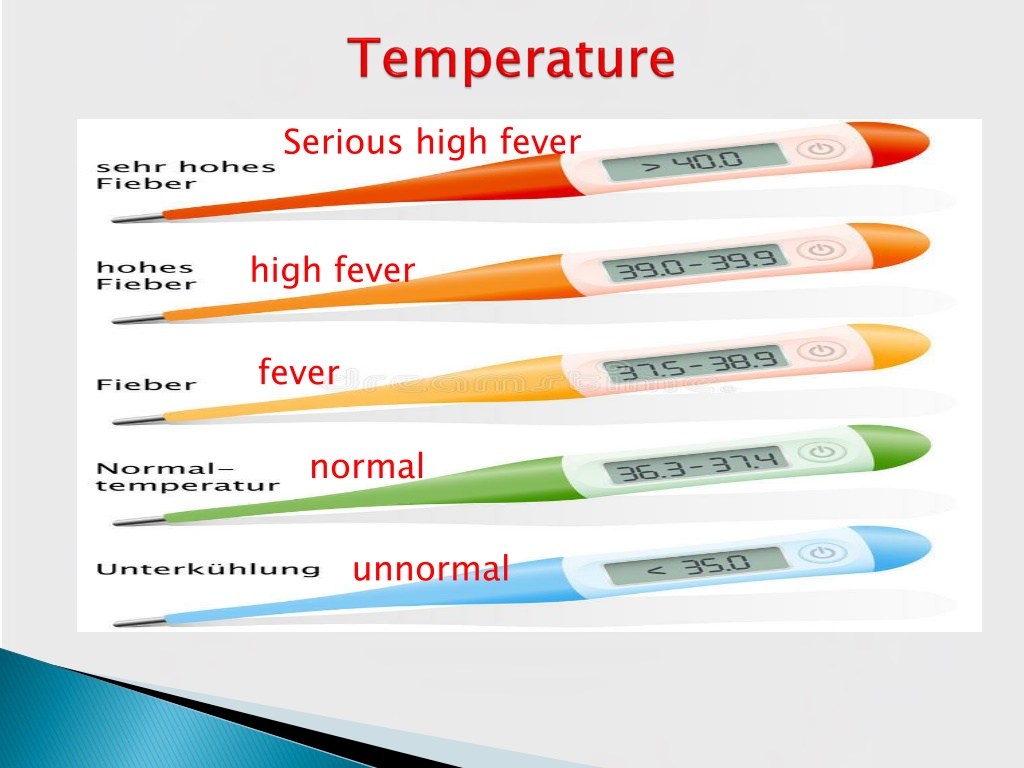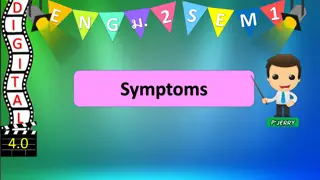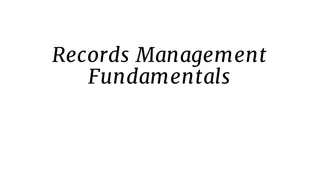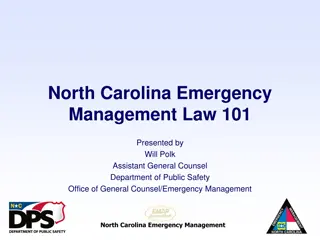Understanding Fevers and Their Management
Fevers can indicate various health conditions like malaria, cold, or childbirth fever. Learn when to apply cool or warm water, give medication, and monitor temperatures for sick individuals. Remember, not all sick people have fevers, and regular temperature checks are essential.
Uploaded on Oct 10, 2024 | 0 Views
Download Presentation

Please find below an Image/Link to download the presentation.
The content on the website is provided AS IS for your information and personal use only. It may not be sold, licensed, or shared on other websites without obtaining consent from the author. Download presentation by click this link. If you encounter any issues during the download, it is possible that the publisher has removed the file from their server.
E N D
Presentation Transcript
Serious high fever high fever fever normal unnormal
Eg1: The normal temperature of a healthy person is about 37 degree. temperature (n) Take sb s temperature Take the patient s temperature The nurses usually take the patient s temperature in the morning +Have a fever ( >37.50C) +have a high fever >< have a mild fever +Have a chill ( < 36.0C) Chill (n)>< fever Eg2: My grandfather had a high fever last night.
Strong/healthy >< ill/sick/tired Healthy person >< sick person patient Rise ( v)= go up >< go down
when a person has a high fever : +apply cool water +give him medicine +take off some parts of his clothes. +give him an intravenous solution when a person has a chill: +apply warm water +cover him with blanket/ clothes. +give him warm drinks
Question 1: what does the nurse use to take the patient s temperature? The nurse uses a thermometer to take the patient s temperature Question 2:Do sick people always have a fever? No, they don t Question 3: How often do you take a sick person s temperature? We should take a sick person s temperature at least 4 times a day
Malaria High fever with chills in a few hours Sweating
Cold with fever Slow pulse Diarrhea and dehydration Trembling and delirium
Mild fever in the afternoon Sweating at night
Childbirth fever Fever Foul-smelling vaginal discharge Pain Bleeding
Fever Fast, shallow breathing Cough with green, yellow or bloody mucus Pain in chest
1. What is shock? 2. What are causes of shock? 3. What are signs of shock?
1. Definition Shock is a life- threatening condition that develops when the body s blood pressure drops dangerously low.
Great pain A large burn Losing a lot of blood Severe illnesses Dehydration Severe allergic reaction - - - - - -
Weak, rapid pulse Cold sweat Pale, cold, damp skin Mental confusion Weakness Loss of consciousness - - - - - -
1. You should take the temperature of a sick person: A. at night B. four times a day C. when he seems to have a fever D. in the morning 2. We can use to take the patients' temperature. A. thermometer B. bite C. kilometer D. kilogram 3. Take the temperature at ..4 times each day and write it down. A. last B. least C. lest D. less 4. is an infection that fills your lungs with fluid. A. Childbirth fever B. typhoid C. pneumonia D. tuberculosis 5. Shock is a medical condition that occurs when body is not getting enough blood flow. A. Dangerous B. threatening C. life- threatening D. immediate
1. In new born babies, a temperature that is unusually high or unusually low (below 36 degree) may mean a 2. People who have ...... usually feel very sick with a high fever and chills 3. .begins like a cold. Temperature goes up a little more each day. Pulse relatively slow. 4. There is a mild fever in the afternoon. At night the person often sweats, and the fever goes down. This disease is 5. People who have a high fever, bad smelling vaginal discharge, lower abdominal pain may have .. serious infection malaria typhoid tuberculosis childbirth fever























